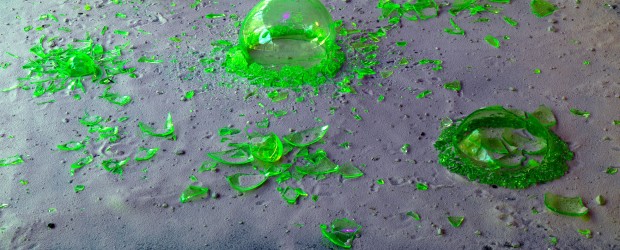Manhattan Project, 2016 - 2017
Manhattan Project, 2016 - 2017
The work Manhattan Project is a model of several failed and successful tests to recreate the perfect dome that occurs 0.025 seconds after detonating an atomic bomb. For the miniature explosions antique Uranium glass, also known as Vaseline glass, was melted and blown to achieve a perfect bubble. Before being used as fuel for nuclear power plants or to produce atomic bombs, uranium was used as colouring agent in the fabrication of tableware and household items. The yellow or light green colour lights up as toxic fluorescent green under UV light. The white sand, coming from White Sands Missile Range where the first atomic bomb exploded, lights up purple, completing the magical and macabre model.
The detonation of the first atomic bomb is the most likely event that will mark the end of the Holocene and the start of the Anthropocene, the age of men. Radioactive isotopes like strontium 90 will be present in the entire geological layer that we are currently creating, functioning as the perfect Golden Spike.
Manhattan Project is part of the artistic research project Triangular Trade in which Vanden Eynde investigates the influence of transatlantic trade of pivotal materials like rubber, oil, ivory, copper, cotton and uranium, on evolution and progress, the creation of nations and other global power structures. The project traces back the origin of the different materials and follows their (r)evolutionary path as they are processed and transformed into 'world changing wonders'.
Maarten Vanden Eynde (BE)
°1977
Maarten Vanden Eyndes' practice is embedded in long term research projects that focus on numerous subjects of social and political relevance such as post-industrialism, capitalism and ecology. Since 2003, Vanden Eynde has been developing an invented field of research called Genetology – the science of first things – that investigates the future legacy of humankind. His work is situated exactly on the borderline between the past and the future; sometimes looking forward to the future of yesterday, sometimes looking back to the history of tomorrow.
Recent exhibitions include Belgian Art Prize Bozar, Brussels, Belgium (2017), 2050. A Brief History of the Future at Palazzo Reale, Milan, Italy (2016) and The Royal Museums of Fine Art, Brussels, Belgium (2015), In_Dependence at Performatik Biennale, Brussels, Belgium (2017), Realitiés Filantes, #4 Biennale de Lubumbashi, D.R. Congo (2015), Beyond Earth Art at Johnson Museum of Art, Ithaca, United States (2014), Ja Natuurlijk/Yes Naturally at Gemeentemuseum Den Haag, The Netherlands (2013), The Deep of the Modern, Manifesta9, Genk, Belgium (2012).
In 2005 he founded Enough Room for Space (ERforS), an interdependent art initiative that initiates and coordinates events, residencies, research projects and exhibitions worldwide, together with Marjolijn Dijkman.


